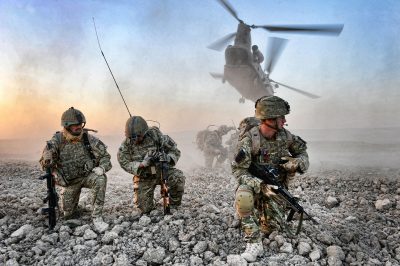US Bombing of Afghanistan Up by 300 Percent

the top US military commander Gen. John Nicholson, television news broadcasters reported that Washington is attempting to stop the Islamist insurgency from “profiting from narcotics trade and other criminal activities.”
The bombing raids in Helmand announced on Monday are merely part of a sharp escalation in the US air war in Afghanistan that is claiming increasing numbers of civilian casualties. Statistics released Tuesday by the US Air Force Central Command establish that the Pentagon is on track to drop more than triple the number of bombs and missiles on the impoverished country this year, compared to 2016.
According to the US military’s own figures, it has dropped 3,554 weapons on Afghanistan during the first 10 months of this year and, at the current rate, is expected to top 4,000 before year’s end. Last month, it recorded 653 bombs and missiles used against Afghan targets, the highest number since November 2010 at the height of the Obama administration’s “surge”, when over 100,000 US troops were deployed in Afghanistan.
The latest raids included strikes by advanced F-22 stealth fighters, which the Pentagon claimed were employed in order to carry out “precision” bombing designed to avoid civilian casualties. This assertion was undercut by the fact that B-52 strategic bombers dropping 2,000-pound bombs were used in the same operation.
Under the new rules of engagement unveiled by the Trump administration in August, the military brass has been given a free hand to escalate the conflict as it sees fit. A total of 16,000 American troops are slated to be on the ground in Afghanistan by the beginning of next year, while the air war is expected to continue escalating
The claims by the Pentagon and the US media that the latest attacks were designed to combat drug trafficking are a patent fabrication aimed at evoking public sympathy for the more than 16 year-old war–America’s longest–that has killed and maimed hundreds of thousands of Afghans, while turning millions into homeless refugees.
The reality is that poppy cultivation and drug trafficking from Afghanistan–which were banned by the Taliban regime–have grown exponentially since the US invaded the country in 2001. In the 16 years of US war and occupation, there has been a 20-fold increase in the territory under poppy cultivation, and the amount of opium produced in the country is 25 times that of 2001.
According to conservative UN estimates, opium production accounts for some 16 per cent of Afghanistan GDP and more than two-thirds of the entire agricultural sector of the country. Not just the Taliban, but government officials, from the top of the US-backed regime of President Ashraf Ghani to local police, are heavily involved in the trafficking of drugs, as are the collection of warlords cultivated by US imperialism as a counterweight to the Taliban.
Local leaders in Helmand province condemned the US raids, saying that they targeted rudimentary sheds in rural areas and did nothing to stop the production and trafficking of opium.
Moreover, among the victims of the airstrikes, unseen in the video-game style footage broadcast on US television news, were Afghan civilians, men, women and children. The entire family of a Helmand resident identified by local authorities as Habibullah was wiped out when a bomb struck their home on the western outskirts of the Musa Kala district center. A total of 12 were killed, including the man, his wife and their children.
The number of civilian casualties is today higher than at any time since the 2001 invasion, with the sharpest increase in deaths caused by air strikes and artillery barrages carried out by US and Afghan puppet forces.
The buildup of troops and airstrikes in Afghanistan is part of a broader US military escalation that is being carried out from the south Asian country, through the Middle East and into ever growing territory on the African continent.
Figures released by the Pentagon indicate that the number of US troops and contractors deployed in the Middle East has risen by 33 percent in the last four months alone, going from 40,517 to 54,180. This is undoubtedly a significant undercount, as the US military often fails to include forces that are rotated in and out of the region on a supposedly temporary basis.
This troop buildup has been carried out without any public announcement, much less debate, and is being decided by the cabal of current and former US generals who largely control US foreign policy. Sharp increases in the number of American troops deployed in a number of Persian Gulf countries are indications of Washington’s preparations for a war against Iran.
According to the latest quarterly reports from the Pentagon, between June and September, the US military deployment increased in the area’s two active war zones; in Iraq, from 8,173 to 9,122 and in Syria, from 1,251 to 1,723.
Far larger increases have been registered in neighboring countries. In Turkey, the number went from 1,405 to 2,265; in Qatar from 3,164 to 6,671; in Bahrain from 6,541 to 9,335; in the United Arab Emirates from 1,531 to 4,240 and in Kuwait, from 14,790 to 16,592. Further increases have been registered across the region, including in Egypt, Israel, Lebanon, Saudi Arabia, Jordan, Yemen and Oman.
The original source of this article is World Socialist Web Site
Copyright © Bill Van Auken, World Socialist Web Site, 2017
Comment on Global Research Articles on our Facebook page
Become a Member of Global Research
No comments:
Post a Comment